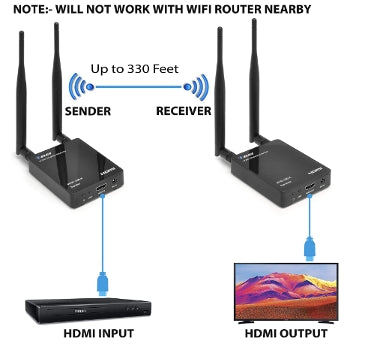Wireless HDMI for Gaming: Pros and Cons
September 18, 2022 3 min read
Wireless HDMI removes HDMI Cables tangled around your gaming console, PC, Laptops, TVs, and monitors. Your space looks neat and clean with no cable, giving a sense of the world without wires.
Just a decade back thinking of a wireless A/V system was perceived to be a unicorn's fantasy. Now, with a plug-n-play, you can connect your HDMI input and output in minutes without any visible wire.
This read will depict when should you use wireless HDMI and why HDMI cables are still preferred. Also, you’ll know the strengths and weaknessesof the wireless A/V system– the problem starts beyond 1080p.

Wireless HDMI For Gaming: An Overview
Back in 2010, When wires were ubiquitous, Intel did something mysterious. It introduced a Wireless Display (WiDi). With WiDi, video signals could travel wirelessly from PCs to certain HD TVs.
But as an introductory tech in the Wireless industry, WiDi began losing the battle due to poor signal integrity, and continuous interruptions. To overcome the flaws of WiDi, the WiFi alliance brought forth Miracast.
Like WiDi, Miracast had to Piggyback on the same hardware as your device’s WiFi connection. It means it has limitations to what you can do over your WiFi.Consequently, the search for powerful Wireless HDMI, especially for gaming purposes, began with full acceleration.
What Exactly Is Wireless HDMI and How Does It Work for Gaming?
As the name suggests, it functions the same as your HDMI cable does. Yet, it won't use any wire– easy to set up. In the most straightforward words, it's Bluetooth, but for videos. You just plug the transmitter into the HDMI Input port from where the video originates and the receiver into Output– Tv, Monitors, or Projectors.
It is important to note that wireless HDMI doesn’t require a Wi-Fi connection. Then how does it work? The transmitter that you insert into the video source device sends out microwaves which the receiver catches, captures, and decodes. So with this much processing happening in milliseconds, can a wireless HDMI provide zero video lagging during the game? This leads to another question.

Is Wireless HDMI Good For Gaming?
Benefits
- Connect source devices such as gaming consoles, PCs, and Laptops with TV and monitors (easy to install).
- Develop Wireless HDMI connection up to 650 Ft.
- The room becomes clean when the messy HDMI cable is replaced with Wireless HDMI.
- Sending an A/V signal to another room with wireless HDMI is a lot easier.
- Most wireless HDMI devices can transmit uncompressed 1080p (HD) video signals, and surround sounds, with 0 latency.
Limitations
- Signal get obstruction as any medium intercepts the transmission.
- Perfect transmission happens when transmission between sender and receiver occurs in a direct line of sight.
- You don’t get any video lag playing game if the distance between transmitters is less than 8 feet.
- Majority of Wireless HDMI connections support 1080p due to lower bandwidth (look below to learn how you can achieve 4k).
Related Stories
Types of HDMI Cables: Summery of Everything on the Internet
Big Difference Between HDMI Switch and Splitter: Crazy Facts
More About 4k Wireless HDMI
Unfortunately, none of the available wireless HDMI transmitters can transmit 4k@60Hz. Even a specific few can support 4k@30Hz. So, the only solution for getting UHD / HDR rests with wired cables built with top-notch material. The bottom line is that wireless HDMI is indeed a facility to join HDMI In-and-Out without weighty wire, but we can't rule out the benefits occurring from HDMI Cables.
Supremacy of HDMI Cable Over Wireless
The unbelievable bandwidth, trusted signal integrity, and above all, compatibility with the majority of gears in the market distinguish HDMI cables from Wireless HDMI.
Also, due to limited bandwidth, wireless HDMI’s aren’t yet able to carry an 8k signal smoothly. On the contrary, HDMI version 2.1, having a bandwidth of 48 Gbps can easily run videos at 8k.
Final Words From UNI
We all love to watch videos, listen to sounds, and get internet connectivity without wires. The tech is advancing in this direction, yet to reap the same benefits which we are getting from the wired systems will take time. Wireless is desired, but a wire is needed. Hope this helps!
Leave a comment
Comments will be approved before showing up.
Also in Blog
How to Distinguish Low-Quality Electronic Waste on E-Commerce Platforms in 2025
March 19, 2025 3 min read
With the rise of online shopping, distinguishing between high-quality electronics and low-quality e-waste has become a critical skill. Many e-commerce platforms are flooded with questionable products that look appealing but often have serious quality and longevity issues.

Maximizing Your Internet Speed: The Ultimate Guide to Using a USB-C to Ethernet Adapter
July 12, 2024 4 min read
Read More Related Stories
· What Is Optic Fiber HDMI Cable?
//
1. [Solved] USB C to HDMI Adapter Cable Not Working in 2022
2. Best Product for Remote Work and Entertainment
3. How to Set Up Dual Monitors for Laptop
4. How to use USB-C to HDMI Cable
5. How to spend time at home during the Covid-19 pandemic?
6. How to choose a suitable USB hub at a good price?
7. How does a 2.5G Ethernet Adapter work with my laptop?
SUPPORT


